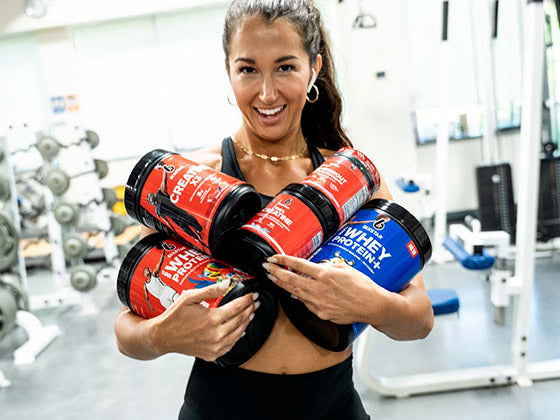If you are an athlete then you might be aware of vertical jumps in sports like basketball and volleyball. If you're new to this, then don't fret, here's a basic breakdown for you: a vertical jump is a measure of how high you can leap off the ground in a straight upward motion.
It's a key indicator of lower body power and explosiveness in sports like basketball, volleyball, and sometimes football as well. The vertical jump is measured by the height reached during a jump, starting from a standing position.
It's a crucial skill for those athletes who play sports that involves blocking shots, grabbing rebounds, or simply reaching higher for best performance. Improving your vertical jump involves enhancing leg strength, explosive power, and your athleticism.
Shop & Save on Protein Supplements
Now, the real question is “Why you should improve your Vertical Jump?”
Well, that's because it comes with several benefits for athletes involved in sports that require explosive movements. Let's have an elaborate look into it.
Why You Should Improve Your Vertical Jump?
As you already know by now that a higher vertical jump is often crucial in sports like basketball for reaching the hoop or blocking shots and in volleyball, it helps in spiking and blocking at the net.
So, if you improved your jump even by an inch then your overall sports performance will be improved as well. Amazing! Right? Other than that, here are a few more reasons:
1. Increased Agility and Power
A stronger vertical jump indicates improved lower body strength and power, contributing to your agility and athleticism on the playing field as a whole.
2. Reaching Your Full Potential
Many sports demand players to reach their highest physical potential. A better vertical jump will allow you to maximize your abilities and contribute more effectively to your team.
3. Competitive Edge
In sports where height and reach matter, an improved vertical jump provides a competitive edge. It can be a game-changer when it comes to outperforming opponents in critical moments.
4. Injury Prevention
Training to improve your vertical jump often involves exercises that strengthen muscles, tendons, and ligaments. This can contribute to better joint stability in your legs and reduce the risk of certain injuries.
5. Versatility in Positioning
A higher vertical jump may increase your versatility on the court or field. It allows for better positioning, whether it's for rebounds, defensive plays, or offensive maneuvers because with a higher reach, you will be able to play all these positions well.
6. Boosted Confidence
Successfully improving your vertical jump is an achievement in itself. This accomplishment can positively impact your confidence, both in training and during actual gameplay.
7. Overall Fitness and Health
Vertical jump training involves a combination of strength, flexibility, and cardiovascular exercises, contributing to your entire fitness and well-being.
How Can You Improve Your Vertical Jump?
If you want to boost your vertical jump, then you should consider practicing the following simple yet effective strategies into your training routine:
1. Do Plyometric Exercises
Involve explosive movements like box jumps, jump squats, and burpees into your workout. Plyometrics increases muscle power and quicken your reaction time that are essential for a higher vertical jump.
2. Focus on Strength Training for Legs
Focus on exercises that target your leg muscles, including squats, lunges, and calf raises. Building strength in these areas will provide the foundation for a more powerful jump.
3. Go For Explosive Movements
Include drills that mimic the explosive actions of a jump, such as jump lunges, broad jumps, and depth jumps. These exercises help train your muscles for rapid force production.
Pre-workout Supplements on SALE
4. Improve Jump Technique and Form
Pay attention to your jump technique. Practice a proper take-off and landing to maximize your efficiency. Engaging the right muscles and maintaining good form can vastly impact your jump height.
6. Focus on Improving Flexibility and Mobility Work
Include stretching and mobility exercises into your routine. Flexible muscles and joints allow for a more extensive range of motion, contributing to an improved jump.
6. Plyometric Box Training
Utilize plyometric boxes of different heights to challenge yourself progressively. This helps train your body to handle different jump heights and improves your entire jumping ability.
7. Include Speed and Agility Drills
Enhance your athleticism with speed and agility drills. These exercises not only improve your coordination but also contribute to the explosiveness needed for a higher vertical jump.
8. Ensure a Balanced Nutrition
Make sure your body gets the fuel it needs for best performance. Include a balanced diet with enough protein for muscle recovery and carbohydrates for energy.
9. Adequate Rest and Recovery
Give your muscles time to recover by including rest days into your training schedule. Quality sleep is also important for effective recovery and performance.
10. Consistent Training
Improvement takes time, so stay consistent with your training routine. Set realistic goals, track your progress, and make adjustments as needed. Remember, gradual progress is key, and listening to your body is major to avoid overtraining.
Exercises You Can Do To Increase Your Vertical Jump
If you want to increase your vertical jump, the include a mix of exercises targeting different muscle groups and aspects of explosive power. Here are a few exercises that can help boost your vertical leap:
1. Squats
Squats will strengthen your quads, hamstrings, and glutes which are crucial for a powerful jump.
How to do it:
Stand with feet shoulder-width apart, squat down, keeping your back straight, and push through your heels to return to the starting position.
2. Lunges
It targets quadriceps, hamstrings, and improves balance.
How to do it:
Step forward with one leg, lowering your hips until both knees are bent at a 90-degree angle. Push back up to the starting position and repeat on the other leg.
3. Calf Raises
Calf exercises strengthen the calves which are important for explosive push-off.
How to do it:
Stand on a flat surface, rise onto the balls of your feet, then lower your heels back down. For added challenge, perform single-leg calf raises.
4. Jump Squats
This exercise Combines strength training with explosive jumping movements.
How to do it:
Perform a squat, then explode into a jump upon rising. Land softly and immediately go into the next squat.
5. Box Jumps
This enhances explosive power in the legs and improves coordination.
How to do it:
Jump onto a sturdy box or platform, landing with both feet. Step back down and repeat.
6. Depth Jumps
It Improves the stretch-shortening cycle, aiding in rapid force production.
How to do it:
Step off an elevated surface and upon landing, immediately jump upward. Focus on a quick transition from the landing to the jump.
7. Plyometric Push-Ups
This mainly engages the upper body while involving some explosive movements.
How to do it:
Perform a push-up with an explosive push-off, allowing your hands to leave the ground. Land softly and immediately go into the next push-up.
8. Medicine Ball Throws
This exercise Engages your core and upper body, enhancing your entire explosive strength.
How to Do it:
Hold a medicine ball and perform explosive throws against a wall or to a partner. Variations include overhead throws and chest passes.
9. Single-Leg Box Jumps
It Targets each leg individually and addresses muscle imbalances.
How to do it:
Similar to box jumps but performed on one leg. Alternate legs for each jump.
10. Resistance Band Exercises
This Enhances your stability and supports overall leg strength.
How to do it:
Use resistance bands for exercises like lateral leg raises, leg curls, and hip flexor exercises to strengthen your supporting muscles.
The Role of Proper Nutrition
Protein is a cornerstone for jump improvement as it plays a central role in muscle repair and growth. When engaging in jump training, your muscles undergo stress, creating micro-tears that need repair. Protein provides the essential amino acids needed for this repair process.
Include protein-rich foods such as lean meats, poultry, fish, eggs, dairy, legumes, and plant-based sources like tofu in your diet. Consider consuming protein both before and after your workouts to support muscle recovery. You can rely on pre workouts and supplements as well for this.
For quality protein, and pre-workout, always consider SixStar.


Along with protein, other nutrients also contribute to muscle your recovery. Carbohydrates replenish glycogen stores, providing energy for your workouts. Whole grains, fruits, and vegetables are excellent sources of complex carbohydrates.
Including healthy fats, found in nuts, seeds, avocados, and olive oil, supports your joint health and helps absorb fat-soluble vitamins essential for recovery. Don't forget micronutrients like vitamins and minerals from fruits and vegetables, they play a role in immune function and your whole well-being.
Staying completely hydrated is often underestimated by young players and athletes but it is vital for good performance and recovery. Water is essential for nutrient transport, temperature regulation, and joint lubrication.
Plan to drink water consistently throughout the day, and pay attention to hydration before, during, and after your workouts. For intense training sessions, consider sports drinks containing electrolytes to replace minerals lost through sweat. Keep in mind that hydration needs vary, so listen to your body and adjust your fluid intake accordingly.
The End Note
As much as you wish to increase your vertical Jump, it is also important to start with a suitable intensity and slowly increase it as your strength and proficiency improve. Remember that Consistency is key, so plan to include these exercises in a well-rounded training program to maximize your vertical jump gains.
BUY SPORTS NUTRITION & SUPPLEMENTS FROM SIXSTAR
Read Our Top Read Blogs:




